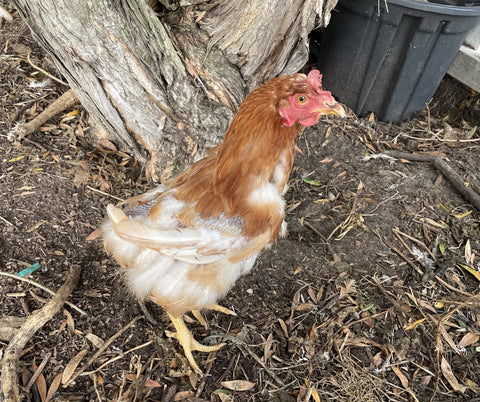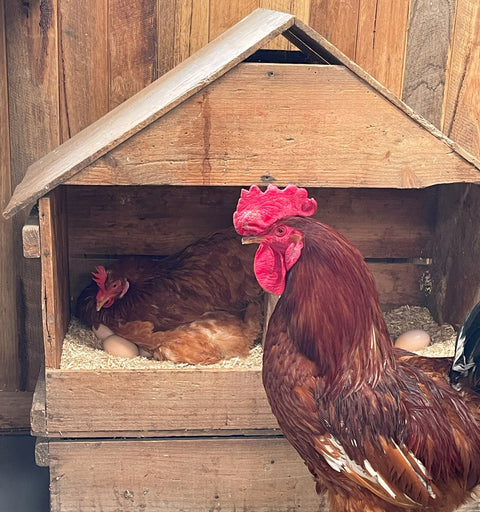If you’ve kept backyard chickens for long, you’ll know that the shorter, cooler days of Autumn can often bring an increase in feathers strewn around the coop. There’s no-need to panic most of the time as it’s just a natural part of what most breeds of chicken will normally do! The shortening autumn days trigger a natural response in chickens: moulting. This annual feather replacement cycle is a sign of healthy hens preparing for winter.
What is a moult?
A moult is the process of shedding old feathers and growing new ones. It typically lasts 6-12 weeks and has a pattern, usually starting at the head and working down to the tail.
Hard and soft moulting?
A “hard” moult is when a lot of a hen’s feathers are lost, often in a short space of time. I often hear from customers who are shocked at the amount of feathers they have found in the chicken coop one morning and assume the hens have been attacked. A hard moult can leave large patches of bare skin on hen’s body but this is quite normal with moutling hens.
A “soft” moult, or what I often term a “pre-moult”, is when you’ll notice a few small patches of feathers missing from your flock members. It can often be seen around the neck and bottom of the hens and can look quite strange. For hybrid hens like the ISA and Hy-Line Browns, they will tend to keep laying during a soft moult and will hold-off from going through a hard moult until around 18 to 24 months of age.
Moulting due to stress
Hens can also moult due to stress in their environment. Environmental stress often takes the form of potential predators such as foxes, eagles, hawks or dogs lurking around the coop. It can also be from less threatening animals such as the nocturnal activities of rodents and possums. Other common stressors are bullying by other hens, poor quality feed, feed or water running out, sickness, poor conditions inside the chicken coop or the activity of common poultry parasites such as mites and lice.
Moulting due to broodiness
Hens that have gone broody and want to sit-on and incubate their eggs, can often start plucking-out the feathers around their “undercarriage”. They do this in an effort to provide more direct heat to the eggs from closer contact with their skin.
How often do chickens moult?
Newly hatched chickens go through several moults on their journey to becoming egg-laying adults (typically 18 to 26 weeks of age). They lose their fluffy, downy feathers over the first 3 to 6 weeks of age to be replaced with their baby feathers. They will then lose these baby feathers (the juvenile moult), around the age of 8 to 13 weeks of age to be replaced by adult feathers. As adult hens, they will usually go through their first hard moult at around the age of 15-18 months. They will then tend to moult on an annual basis.
Diet and moulting?
Both hard and soft moulting takes it’s toll on a hen’s body as it is very taxing on their system. This is particularly true for the better laying purebreds and hybrid hens. To continue to lay eggs to her potential and go through a moult takes a hen in excellent condition supported by excellent nutrition. This is because the hen, her eggs and feathers all have large protein needs. With chickens often seen in the past (and even now!), as scrap-eating, “eat whatever” animals, many diets and chicken feeds contain insufficient levels of protein and nutrients. This means that something has to give and the first is egg laying quite apart from the compromised condition of feathers and body condition.
The importance of protein
Chicken feathers contain around 85% protein called Keratin so need a lot of high-quality protein in their diet to grow their new feathers when moulting. Fresh, raw eggs consist of water 76.1%, protein 12.6%, fat 9.5%, ash 1.1% and carbohydrates 0.7% in research by the National Library of Medicine. This means that protein, in regard to the nutritional benefits it provides, is higher than all other components combined. Finally, we “start at the beginning” with the protein needed by each hen per day to maintain her own muscle tissue, eggs, feather and overal condition. Hens need around 17.42% and 18.25% protein in their diet for their first, most productive laying season.
Why does moulting happen?
It signals the end of their annual laying cycle. Every breed of chicken moults, even the highly-productive hybrid laying hens like Hy-Line and ISA Browns. The difference is that they don’t tend to go into a hard moult until much later than purebred hens and their egg production may only decrease slightly.
Importantly, a moult allows a hen's body some for rest and recovery from the demands of egg laying. Not only does it allow for the replacement of worn-out plumage but it also gives her ovary and oviduct a chance to rejuvenate. With each subsequent moult that the hen undergoes, future laying cycles will tend to produce fewer eggs.
What happens after feather loss?
New feathers start to grow as soon as the old feathers fall away. The new feathers are called “pin” feather and start to poke through the old feather follicle as opaque stubs. You can often see the blood supply to these stubs which is the reason why they are sometimes know as “blood” feathers.
This can be a sensitive time for hens so avoid handling them until the feathers are fully developed and don’t place any sort of cover on hens to help keep them warm. If you see any signs of blood or irritation around the pin feathers, immediately but carefully remove the hen from the flock and spray a suitable animal wound spray on the affected area such as Cetrigen.
Caring for your moulting chickens – Key Points
Moulting can be a stressful time for our backyard chickens so be extra vigilant, attentive and supportive. Here are seven areas to be aware of so that you can help your flock complete the moulting process successfully and come out the other side smiling:
- Stay Alert to Health Risks: Moulting can leave chickens more vulnerable to illness due to their raised stress levels. This can lower their immune system response and allow any diseases they may have been carrying or new ones, to start affecting them. Keep a watchful eye out for external parasites as well and act fast to manage any outbreaks using non-chemical, natural options where possible.
- Protein Power: As you’ve read, feather creation takes serious protein. Ensure your flock is getting a balanced, high-quality feed with the correct percentage of protein to best support moulting hens during this demanding time. Not only do they need to maintain their regular physiological systems but they now have to grow feathers and stay warm while half bald! They’ll need the best nutrition possible to achieve this.
- Treats are Tempting, But... It's better to hold off on too many treats. You really want your hens to be focused on the protein, essential minerals, trace elements and vitamins in their well-balanced chicken feed. Many treats will not add a lot as far as the right sort of protein needed by moulting hens. Healthy treats such as meal worms, black soldier fly larvae, hemp seeds and fish meal can all provide protein boost when used in moderation.
- Pecking Problems: Remember those pin feathers – where new feathers emerge? They're packed with blood and irresistible to curious (and bored) flock mates. Pecking can become harmful and even fatal. Use distractions like healthy peck blocks and immediately isolate hens who are being targeted. For injured birds, use an antiseptic wound spray and keep them safely isolated until fully healed.
-
Cosy Coop = Happy Hens: Bald patches from moulting mean your hens might feel the chill more than usual. Make sure their coop is dry, draft-free and comfortable so keep bedding and nesting materials fresh and clean. We don’t want driving rain to enter the coop and run as well so provide extra protection if needed.
-
Reduce the Stress: Avoid making sudden changes like adding new hens while any of your existing flock members are moulting. Keep up a regular routine, provide constant access to food and fresh water and keep handling to a minimum – those pin feathers are sensitive!
-
A Boost for Recovery: Consider a supplement like Vitality Booster during and after the moult. These specially formulated mixtures provide a range of extra nutrients and vitamins to aid energy levels and overall recovery throughout the moulting process.
Additional Things to Keep in Mind
- Intensity and Duration Varies: Some hens experience a hard moult with dramatic feather loss and a complete stop in egg-laying, while others only shed a few feathers here and there. Some moults last just a few weeks while some go on for three or more months. Don't be alarmed by variations!
- Time for TLC: Even if egg production is down, show your moulting chickens some extra love. They'll appreciate the care and reassurance.
- Record-Keeping Rocks: Note down when your hens moult each year – this helps you anticipate future cycles and have supplies ready when needed.
Moulting can seem a bit alarming for new chicken owners but it's a perfectly normal and beneficial process for your flock. Understanding the reasons behind it and providing the right support will help your feathered friends breeze through their annual wardrobe change and come back stronger than ever!







Comments (3)
Thankyou for the fantastic information.
It is so interesting to read and certainly helps with looking after our 4 gorgeous girls who give us such scrumptious eggs, plus plenty of laughs as they look through our windows at us inside when the are scratching the ground.
Well researched and informative thanks so much
Thanks again for the information to keep the girls as happy & healthy as we possibly can.